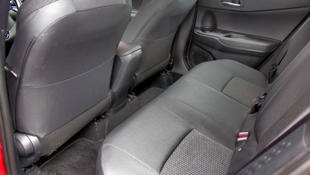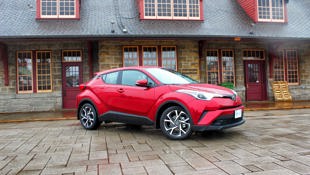A few years ago, Toyota boss Akio Toyoda famously declared, “No boring cars.” The designers of the 2018 Toyota C-HR took this missive (and maybe a hit of acid) and blasted off to Planet Origami. Arriving in showrooms early May, the C-HR (compact high-rider) is a boldly creased compact crossover aimed at the same youthful urban demographic that might be kicking the tires of a Nissan Juke or Kia Soul. This vehicle was originally intended for the Scion lineup in North America, but with the demise of Toyota’s youth-oriented brand, it wears a Toyota badge.
It’s a head-turner.
The C-HR’s skin is almost unchanged from the concept vehicle shown at the 2015 Frankfurt auto show, and by the reaction this crossover garnered as our colourful convoy made its way through downtown Montreal, it’s a head-turner.
That said, the C-HR is more cohesive than outrageous, looking purposeful and planted. Toyota speaks of the “sexy diamond” theme, and this motif is found looking at its flanks, where the roofline and wheel arch creases frame a diamond. Inside, the theme is echoed by the air vents, speaker covers, button clusters, door panel pattern and some embossing on the headliner.
Initial interior impressions are good. The fabric seats are comfy and supportive, and soft-touch surfaces abound. The standard leather wheel has Land Rover-grade hide, and doors (with nicely padded pulls) close with solid authority.
Pricing starts at $24,690 for the C-HR XLE. It gets heated seats, 17-inch alloys, dual-zone climate control, 7-inch display, six-speaker audio, auto-dimming interior and full-boat Toyota Safety Sense (TSS-P) that includes adaptive cruise with full stop, auto high-beams, pre-collision with pedestrian detection and lane-departure alert with steering correction.
As this crossover is aimed at wired-up millennials, not having Apple CarPlay or Android Auto is a glaring oversight. Toyota is going with the Aha smartphone integrated audio system.
Power comes from a new-to-North America 2.0L naturally aspirated four that puts out 144 hp and 139 lb-ft at 3,800 rpm. Transmission duties are handled by a continuously variable transmission featuring seven programmed steps designed to mimic the feel of a “normal” gearbox. The C-HR rides on Toyota’s new TNGA platform that debuted on the latest Prius, and to keep things simple and prices in check, this is a front-wheel-drive-only crossover. There are no plans for AWD or a hybrid version.
On our rainy test day, the C-HR showed a sense of dynamic poise and refinement that signals a new direction for the automaker. As would be expected, the TNGA architecture is lighter and stiffer, and here features front struts and multilink rear suspension. The suspension engineers have done a fine job of combining excellent body control and flat cornering with a quiet ride that is on the firm side, but always composed and never intrusive. In this regard, it puts the Mazda CX-3 and Honda HR-V on the trailer.
This whole “Nürburgring-tuned” thing might be becoming quite the cliché (I think my toaster brags that), but driving the C-HR makes me think chief engineer Hiro Koba (who races bikes and a Toyota 86) tuned this crossover with care. Steering is direct and nicely weighted, and the brakes firm and linear. The best Toyota chassis I’ve driven.
Things fall a little flat under the hood, but I’m guessing most millennials are not rabid hot-shoes. The 144 hp 2.0L four provides adequate motivation and it pairs nicely with the CVT that largely avoids the dreaded droning when calling for meaningful thrust. Still, at 1,497 kg, the C-HR is a porker for this class, and you can feel the four-pot working against this when merging or trying to pass. Once settled into a pace, the cabin is the model of serenity thanks to Toyota’s targeted sound insulation.
The thick C-pillars and stylishly raked roof line impede rear visibility, and if any kids are sitting back there, they won’t see much out of the small windows that sit high up in the bodywork. Surprisingly, the back seats show decent legroom and headroom – at just under six feet, I could “sit behind myself” comfortably. Behind the rear seat is 538 L of cargo space, splitting the difference between the Honda HR-V (688 L) and the Mazda CX-3 (454 L). The 60/40 rear seat folds to create a flat load floor.
In the spirit of the (expired) Scion brand, there is but one upgrade package for the 2018 Toyota C-HR. The $1,600 Premium Package bestows 18-inch alloys, blind-spot monitoring with rear cross-traffic alert, push-button start, Smart Key System and power folding mirrors with puddle lamps that project a groovy C-HR logo onto the terra firma. Some paint hues cost extra as does the two-tone treatment.
So how does this bravely sculpted compact crossover fit into the automotive landscape? When it comes to ease of use and general comfort, it is all Toyota. What surprises is its poise and refinement. The lack of Android Auto and Apple CarPlay may be an issue, but the list of standard fare is generous, highlighted by its comprehensive safety suite. The 2018 Toyota C-HR might be funky, but it has some substance to back up its style.
































